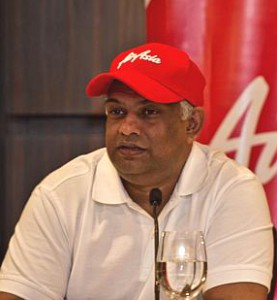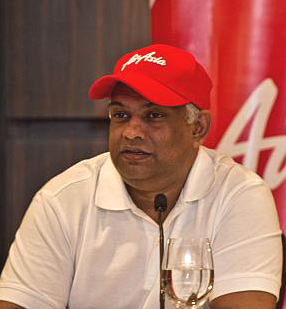 AIRASIA Group’s CEO Tony Fernandes sees the low-cost carrier company’s Philippine associate as a “long-term story” after the unit’s revenue more than tripled year on year and its net loss narrowed during the second quarter.
AIRASIA Group’s CEO Tony Fernandes sees the low-cost carrier company’s Philippine associate as a “long-term story” after the unit’s revenue more than tripled year on year and its net loss narrowed during the second quarter.
Fernandes made the remarks in his outlook for the group’s regional units in Malaysia, Thailand, Indonesia and the Philippines as the company recently reported strong performance for the second quarter of the year ended June 30.
“I am excited about the outlook. The infrastructures are set up and our assets are strong, the associates and joint-venture companies are powering up the engines producing healthy numbers and starting to contribute to our bottom line,” Fernandes said.
Air Asia Group noted that Philippines AirAsia has been in operations just over a year and saw a 304% year-on-year increase in revenue in the second quarter.
“Philippines AirAsia… will be a long-term story. The strategic alliance with Zest Air is only the first step and a lot more work needs to be done in terms of integration and rationalisation of routes and resources, and maximising the slots in Manila,” Fernandes said.
He said the Philippines’ expected exit from Category 2 by early 2014 would also boost the continued growth of visitor arrivals in the country.
The associate, headed by CEO Maan Hontiveros, recorded a lower net loss during the quarter under review. As AirAsia’s interest in PAA has been reduced to zero, any profits will only be recognized once the invested amount has been reversed, the group said.
“The recent strategic alliance with Zest Air which was officially approved on 10 May 2013 boosted PAA’s operational numbers,” Hontiveros said in the same report.
She said total passengers carried during the quarter surged 114% to about 140,000, which led to a 28 percentage point increase in load factor to 76%, from 48% in the second quarter last year.
Revenue per available seat per kilometer (RASK) also surged 66% and cost per available seat per kilometer (CASK) dropped 43% year on year, “which means that we are moving in the right direction. Further integration is being done between PAA and Zest Air, focusing on the maximization of high value Manila slots,” Hontiveros said.
Fernandes said Air Asia was beginning to see healthy contributions from its affiliates and adjacent businesses. In 2Q13, AirAsia Bhd recognized a total profit of RM12.9 million from its associates and jointly controlled entities – a profit of 22 million ringgit (US$6.8 million) as equity share in Thai AirAsia, a profit of 2.5 million ringgit in Asian Aviation of Excellence Sdn Bhd, a loss of 3.7 million ringgit from AAE Travel Pte Ltd., and a loss of RM7.9 million ringgit from AirAsia Japan.
The company also reported a gain of 78.27 million ringgit from the disposal of interest in AirAsia Japan, following the dissolution of the joint-venture between AirAsia Bhd. and All Nippon Airways announced on June 25.
“We are thrilled that we got out of this joint venture as we felt the other partners do not share similar vision we envisage for AirAsia Japan. The key thing for me is that the company was able to recoup all our investment back from this joint venture,” Fernandes said.
Commenting on the outlook for the company, he said, “Our focus now is to improve loads and passenger growth by offering low fares, while driving costs down and at the same time increasing ancillary take up.”
“The outlook looks good in the second half of the year, coming into the festive and holiday season,” Fernandes said.
He said Malaysia Air Asia is expected to record strong passenger numbers in August due to the Hari Raya and school holidays, while with Thailand AirAsia, “we have been seeing commendable numbers coming from the associate, operationally and financially.”
“Indonesia Air Asia is showing positive numbers now as its distribution strategy beginning to bear fruit and the brand is strong, which allows us to be competitive with the larger players,” he said. “We will continue to garner more domestic market share in Indonesia by targeting 17% of the distribution channel being travel agents.”





